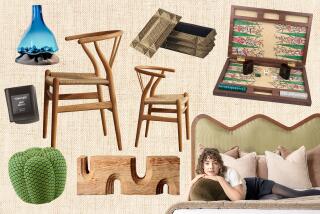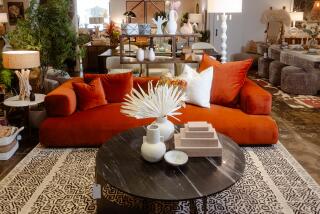Cabinet Reshuffle : How Four Masterworks of Victorian Furniture Were Reunited After More Than 80 Years of Travels
- Share via
Families that have been reunited are a regular standby of television news programs. It is always a moving moment when two brothers, or a mother and daughter, who have not seen each other for perhaps 40 years are brought together again, with decades of missed love to make up for. At first they may not seem to have much in common, but as they talk, family traits reassert themselves, and we discern something about the eyes, or the cast of the head, that makes these people kin.
Less movingly but no less miraculously, the same kind of thing can happen with antiques. One such happy reunion has been achieved by the Fine Art Society in London. Founded in 1876, the society--almost opposite Sotheby’s on New Bond Street--is not, as its name suggests, some exclusive private club for dilettantes, but one of London’s leading commercial art galleries. It specializes in 19th-Century and early 20th-Century paintings and also in decorative arts of those periods--William Morris tapestries, furniture by Charles Rennie Mackintosh, silver by Archibald Knox and Omar Ramsden.
In 1981, the society held an exhibition titled “Architect-Designers: (A. W.) Pugin to (C. R.) Mackintosh.” In it was a handsome ebony-and-ivory cabinet inlaid with the owner’s monogram, “A. M.” It had been acquired by the FAS from a London dealer who had bought it at Christie’s auction room in South Kensington, London, where it had been catalogued as Italian. But Peyton Skipwith, a director of the FAS, realized that the initials on the cabinet stood for Alfred Morrison, a stupendously rich collector of the late 19th Century. Morrison had lived at Fonthill House, Wiltshire, an extension of part of Fonthill Abbey, built for another prodigal collector, William Beckford, author of the Gothic novel “Vathek.” Morrison (1821-97) in herited a fortune of several million pounds, which he increased through the firm of Morrison & Dillon, the first modern department store in London.
Further research showed that the cabinet had been designed for Morrison in 1862 by Owen Jones, whose picture book “The Grammar of Ornament” (1856) was the bible of so many Victorian craftsmen in “revivalist” styles--that is, styles that revived the ornament of the Italian Renaissance, of Moorish Spain and other great cultures.
In 1984, a huge, fitted display cabinet in ebony and ivory was bought in France by Italian antique dealers based in London. It was sold to them as an Italian piece and was displayed by them as Italian until someone pointed out to them an illustration of the smaller cabinet in the FAS exhibition of 1981. They then offered the large cabinet to the society, which bought it.
Last fall, an over-mantel mirror, painted glossy white, turned up at Sotheby’s. Skipwith had a hunch about it and bought it for the society. Sure enough, under the paint was ebony with ivory inlay, a perfect match to the two pieces already in the possession of the FAS. It had been used as a bathroom mirror for some years. Because ebony has such a close grain, it is virtually impervious to paint, so the mirror cleaned well, and the inlay was intact.
The three pieces, now on show on New Bond Street, were made for Morrison by the furniture firm Jackson & Graham between 1862 and 1865 as part of refurbishments at Fonthill House. Jackson & Graham also made furniture to Jones’ design for Morrison’s London house, 16 Carlton House Terrace, between 1864 and 1868; and recently the FAS has been able to borrow, for temporary exhibition, a sofa from these London furnishings, inlaid with exotic woods.
The Fonthill and the Carlton House Terrace properties were vacated by Morrison’s widow in the early 1900s. The furniture was given away or sold through the firm of John Walton in Mere, Wiltshire, which has kept no records. In 1952, the Victoria & Albert Museum, London, staged a pioneering exhibition of Victorian and Edwardian decorative arts. The museum staff failed to trace any of the Morrison furniture. It was not until 20 years later, when the museum acquired a small cabinet found in an attic at Carlton House Terrace, that Jones’ important work for Morrison was represented in a British national collection. This cabinet and a few pieces that the museum already possessed and that had been designed by Jones for one James Mason (not, of course, the James Mason) at Eynsham House, Oxford, were the total of Jones’ known furniture design until the pieces now at the FAS appeared.
The acquisition of the furniture made Skipwith want to know more about Alfred Morrison and his wife. He learned much about both of them from an essay on Morrison’s wife, Mabel, in the book “Four Victorian Ladies of Wiltshire” (1945) by Edith Olivier, a cousin of Laurence Olivier. Alfred Morrison had been a great collector of Chinese porcelain and of autographs--especially autographs of Lord Nelson and Lady Hamilton. (When Owen Jones saw Morrison’s Chinese wares he felt remorse at having represented Chinese designs inadequately in “The Grammar of Ornament,” and as a direct result he produced another book, “Examples of Chinese Ornament,” in 1867.)
The J. Paul Getty Museum in Malibu has some porcelain labeled “Fonthill” on the bases. At first the museum’s experts thought the porcelain must be from the Fonthill collection of William Beckford--a collection sneered at by William Hazlitt in a famous essay. Then the Getty staff realized that the collector was Morrison. Edith Olivier describes the house as it was in Morrison’s day, when the Owen Jones furniture was still in situ :
“Morrison added three galleries, ugly rooms, but apt for their purpose, which was to display the collection under a top light. The windowless walls gave the rooms a peculiar subterranean character. The marble staircase was carpeted with leopard skins, and the magnificent Oriental china was given a Crystal Palace-like room opening onto the garden. The Morrisons bought not only antiques: They considered that a rich collector should encourage contemporary art, so they welcomed to their house lace makers, painters, enamelists and embroiderers.”
The collection of paintings was not large; but (Olivier suggested) “no gallery can be considered negligible which contains some of the choicest of the existing Clouets; and the name of the owner of the Madonna and Child by that anonymous Flemish painter known only as ‘the Master of the Morrison Triptych’ has an assured place in the history of aesthetics.” One of the Clouets was the portrait of Mary, Queen of Scots, known as “Le Deuil Blanc.”
The Morrisons entertained many distinguished people in the Fonthill and London houses: George Eliot, singer Jenny Lind, Robert Browning (a frequent dinner guest), artists William Holman Hunt and Lord Leighton. Rudyard Kipling was among their country neighbors. He named Mabel Morrison “the Queen of Sheba” because of the Oriental jewels she liked to wear.
What would William Beckford have thought of the Morrisons’ reworking of Fonthill? With his penchant for exotic Orientalism, he probably would have approved. In Morrison’s youth, there were workmen in the Fonthill area who remembered Beckford only too well. He had treated them like the slaves on his Jamaican plantations, thrashing with his own hands one laborer when work on a waterfall was not carried out to his satisfaction.
On just one occasion, the two successive owners of Fonthill met. Edith Olivier describes it:
“William Beckford lived on in Bath (the city near Fonthill) till 1844, and about the year 1843, Alfred Morrison walked up one afternoon to the terrace to look at (Fonthill) Abbey, a ruin since its great tower fell in upon it in 1825. Another visitor was there before him. An old gentleman, mounted on a sturdy little cob, had halted some way off, and he was gazing at the wood and at the ruins in so absorbed a fashion that he never observed the young man who had come upon him. It was William Beckford. He had ridden over from Bath to look for the last time on all that remained of the most stupendous of all the follies which he and his contemporaries had set upon a hundred hilltops. The old man and the young man looked at it in silence, and then each returned to his own place.”
More to Read
The biggest entertainment stories
Get our big stories about Hollywood, film, television, music, arts, culture and more right in your inbox as soon as they publish.
You may occasionally receive promotional content from the Los Angeles Times.










